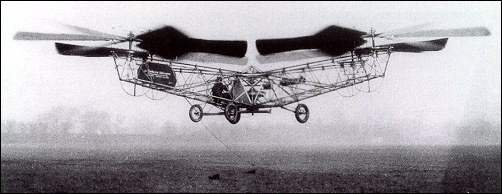
| De Bothezat 1922 |  |
 |

| De Bothezat 1922 |  |
 |
|
In January 1921, the US Army Air Corps awarded a contract to Dr. George de Bothezat and Ivan Jerome to develop a vertical flight machine. The 1678kg "X"-shaped structure supported a 8.1m diameter six-blade rotor at each end of the 9m arms. At the ends of the lateral arms, two small propellers with variable pitch were used for thrusting and yaw control. A small lifting rotor was also mounted above the 180hp Le Rhone radial engine (which it also cooled) at the junction of the frames, but was later removed as unnecessary. Each rotor had individual collective pitch control to produce differential thrust through vehicle inclination for translation. The aircraft weighed 1700kg at take-off and made its first flight in October 1922. The engine was soon upgraded to a 220hp Bentley BR-2 rotary. About 100 flights were made by the end of 1923 at what would eventually be known as Wright Field near Dayton, Ohio, including one with three "passengers" hanging onto the airframe. Although the contract called for a 100m hover, the highest it ever reached was about 5m. After expending $200,000, de Bothezat demonstrated that his vehicle could be quite stable and that the practical helicopter was theoretically possible. It was, however, underpowered, unresponsive, mechanically complex and susceptible to reliability problems. Pilot workload was too high during hover to attempt lateral motion. In the late 1930s, de Bothezat built a single seat, coaxial helicopter with even less success.
The first rotorcraft ordered by the United States Army was made by de Bothezat. This Russian engineer who had emigrated to the United States started in July 1921 to build a helicopter at Dayton under the auspices of the United States Air Service. The helicopter had four six-bladed rotors mounted at the ends of beams 20 metres in length, forming a cross and intersecting in all directions. The rotor axes were not parallel but slightly inclined inwards so that if prolonged they would have met at a point directly above the centre of gravity. Besides the rotors with variable-pitch blades, the helicopter had two horizontal propellers called 'steering airscrews' as well as two small airscrews placed above the gearbox and acting as regulators for the 220hp engine. Ready for flight, the helicopter weighed 1610kg. On 18th December 1922 during a test by the Technical Section at McCook Field (now known as Wright Field), the aircraft rose 1.8 metres from the ground and remained airborne for 1 minute 42 seconds. On 19th January 1923 it lifted two persons to a height of 1.2 metres, and on 17th April 1923 it lifted not only the pilot but also four people hanging on to the framework. Because of its great moment of inertia, the helicopter proved quite stable, yet despite the series of sustained flights which it performed, the Air Corps rapidly lost interest in it. P.Lambermont "Helicopters and Autogyros of the World", 1958
A machine which was less complex than Sikorsky's first prototype but equally heavy - almost a 1922 version of the famous Breguet No.1 - was flown by a Russian emigre to the United States, de Bothezat, on 18 December of that year. The 1600kg vehicle, with a 220hp engine, lifted itself to a height of 1.80m and stayed in the air for one minute, 42 seconds. But the US Air Force was more interested in autogyros and blocked funds to de Bothezat, who was thus obliged to give up his experiments. G.Apostolo "The Illustrated Encyclopedia of Helicopters", 1984
| ||||||||||||||||||||||||||||||||||||||

|
|
 |